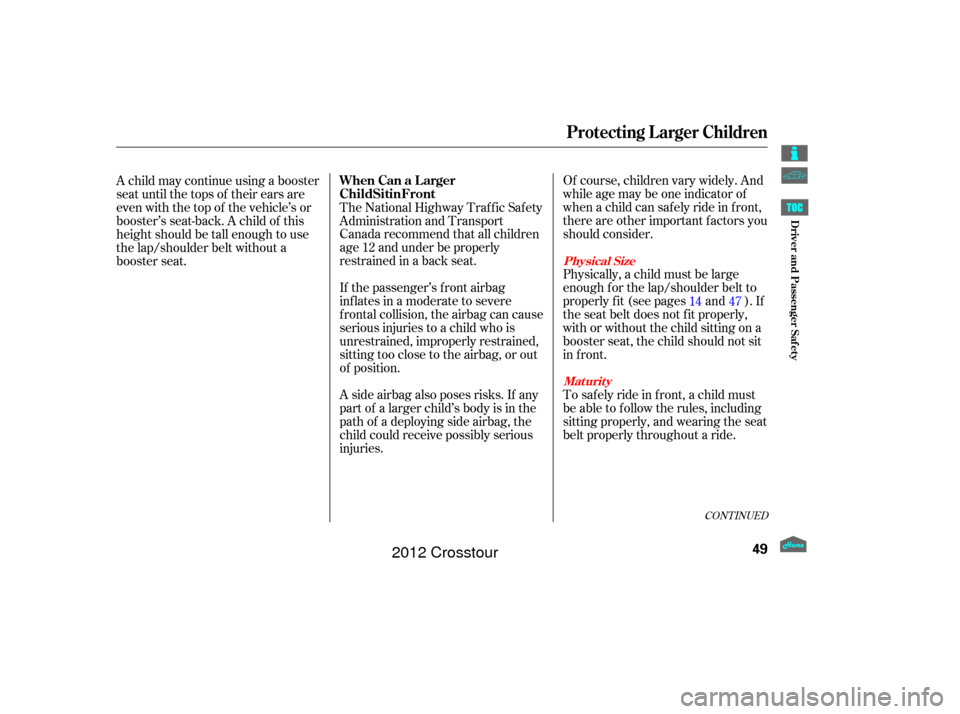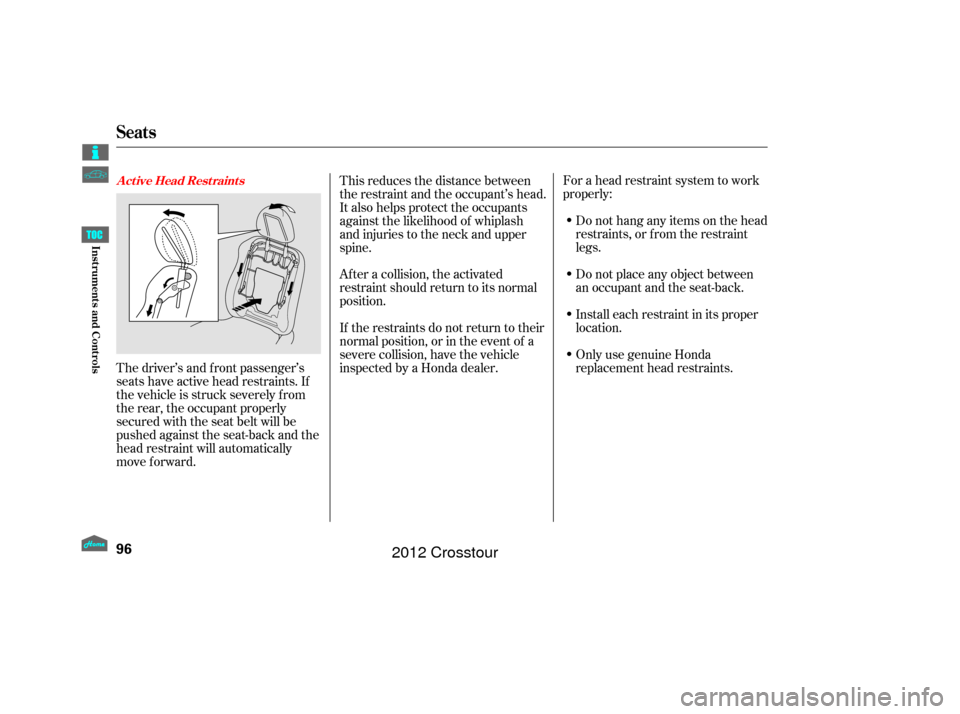Page 53 of 435

CONT INUED
Of course, children vary widely. And
while age may be one indicator of
when a child can saf ely ride in f ront,
there are other important f actors you
should consider.
Physically, a child must be large
enough f or the lap/shoulder belt to
properly f it (see pages and ). If
the seat belt does not f it properly,
with or without the child sitting on a
booster seat, the child should not sit
in f ront.
To saf ely ride in f ront, a child must
be able to f ollow the rules, including
sitting properly, and wearing the seat
belt properly throughout a ride.
The National Highway Traffic Safety
Administration and Transport
Canada recommend that all children
age 12 and under be properly
restrained in a back seat.
If the passenger’s front airbag
inf lates in a moderate to severe
f rontal collision, the airbag can cause
serious injuries to a child who is
unrestrained, improperly restrained,
sitting too close to the airbag, or out
of position.
A side airbag also poses risks. If any
part of a larger child’s body is in the
path of a deploying side airbag, the
child could receive possibly serious
injuries.
A child may continue using a booster
seat until the tops of their ears are
even with the top of the vehicle’s or
booster’s seat-back. A child of this
height should be tall enough to use
the lap/shoulder belt without a
booster seat.
14 47
Protecting L arger Children
Physical Size
Maturity
When Can a Larger
49
Driver and Passenger Saf ety
Child Sit in Front
2012 Crosstour
Page 54 of 435

Devices intended to
improve a child’s comf ort or
reposition the shoulder part of a
seat belt can make the belt less
ef f ective and increase the chance
of serious injury in a crash.
This could result
in serious neck injuries during a
crash.
This could
cause very serious injuries during
a crash. It also increases the
chance that the child will slide
under the belt in a crash and be
injured.
If they do, they
could be very seriously injured in a
crash.
If you decide that a child can saf ely
ride up f ront, be sure to:
Caref ully read the owner’s manual,
and make sure you understand all
seat belt instructions and all saf ety
inf ormation.
Move the vehicle seat to the rear-
most position.
Have the child sit up straight, back
against the seat, and feet on or
near the f loor.
Check that the child’s seat belt is
properly and securely positioned.
Supervise the child. Even mature
children sometimes need to be
reminded to f asten the seat belts
or sit properly.
Protecting L arger Children
Do not put any accessories on aseat belt.
Do not let a child wear a seat belt
across t he neck.
Do not let a child put the shoulderpart of a seat belt behind t he backor under t he arm.
T wo children should never use thesame seat belt .Additional Saf ety Precautions
50
Driver and Passenger Saf ety
2012 Crosstour
Page 59 of 435

The U.S. instrument panel is shown. Dif f erences f or the Canadian models are noted in the text.
Instrument Panel
55
LOW FUEL INDICATOR
ANTI-LOCK BRAKE SYSTEM
(ABS) INDICATOR
LIGHTS ON INDICATOR
CRUISE CONTROL
INDICATOR
(P.61)
(P. 57)
(P.58)
(P.
62)
CRUISE CONTROL
MAIN INDICATOR
(P.
62)
(P.56) (P.
60)
(P.59)
(P.61)
HIGH BEAM INDICATOR
MAINTENANCE MINDER INDICATOR (P.62) (P.60)
TIRE PRESSURE MONITORING
SYSTEM (TPMS) INDICATOR (P.59)
DAYTIME RUNNING LIGHTS INDICATOR (P.61
)
PARKING BRAKE AND BRAKE SYSTEM INDICATOR (P.57)
(P.58) FUEL ECONOMY INDICATOR (P.59) SIDE AIRBAG OFF INDICATOR
LOW TIRE PRESSURE
INDICATOR
SEAT BELT REMINDER
INDICATOR
DOOR AND TAILGATE OPEN INDICATOR
MALFUNCTION INDICATOR LAMP SECURITY SYSTEM INDICATOR
CHARGING SYSTEM INDICATOR
LOW OIL PRESSURE INDICATOR
IMMOBILIZER SYSTEM
INDICATOR (P.62) (P.61)
VEHICLE STABILITY ASSIST (VSA) SYSTEM
INDICATOR VSA OFF INDICATOR (P.58)
SUPPLEMENTAL RESTRAINT
SYSTEM (SRS) INDICATOR (P.57)
(P.56,
386)
(P.56, 386)
(P.56,387) FOG LIGHT INDICATOR (P.62)
Inst rument s and Cont rols
2012 Crosstour
Page 60 of 435

The instrument panel has many
indicators to give you important
inf ormation about your vehicle.The engine can be severely damaged
if this indicator f lashes or stays on
when the engine is running. For
more information, see page .
If this indicator comes on when the
engine is running, the battery is not
being charged. For more inf ormation,
see page .
See page .
If your f ront passenger does not
f asten their seat belt, the indicator
comes on about 6 seconds af ter the
ignition switch is turned to the ON
(II) position.
If either of you do not f asten your
seat belt while driving, the beeper
will sound and the indicator will f lash
again at regular intervals. For more
inf ormation, see page .
This indicator comes on when you
turn the ignition switch to the ON
(II) position. It reminds you and your
passengers to f asten your seat belts.
A beeper also sounds if you have not
f astened your seat belt.
If you turn the ignition switch to the
ON (II) position bef ore f astening
your seat belt, the beeper sounds
and the indicator f lashes. If you do
notfastenyourseatbeltbeforethe
beeper stops, the indicator stops
f lashing but remains on. 18
386
386 387
L ow Oil Pressure
Indicator
Charging System
Indicator
Malf unction Indicator
Lamp
Seat Belt Reminder
Indicator
Instrument Panel Indicators
56
Inst rument s and Cont rols
2012 Crosstour
Page 100 of 435

For a head restraint system to work
properly:Do not hang any items on the head
restraints, or f rom the restraint
legs.
Do not place any object between
an occupant and the seat-back.
Install each restraint in its proper
location.
Only use genuine Honda
replacement head restraints.
If the restraints do not return to their
normal position, or in the event of a
severe collision, have the vehicle
inspected by a Honda dealer. Af ter a collision, the activated
restraint should return to its normal
position. This reduces the distance between
the restraint and the occupant’s head.
It also helps protect the occupants
against the likelihood of whiplash
and injuries to the neck and upper
spine.
The driver’s and f ront passenger’s
seats have active head restraints. If
the vehicle is struck severely f rom
the rear, the occupant properly
secured with the seat belt will be
pushed against the seat-back and the
head restraint will automatically
move forward.A ct ive Head Rest raint s
Seats
96
Inst rument s and Cont rols
2012 Crosstour
Page 102 of 435

How to use the lever on both sides of
the cargo room.Do not put any heavy items on the
seat-back when it is folded down.
Make sure the seat-back is locked
securely and all rear shoulder belts
are positioned in f ront of the rear
seat-backs.
Make sure all items in the cargo area
are secured. Loose items can f ly
f orward and cause injury if you have
to brake hard. See
on page .
To return the seat-back to the
upright position, raise the seat-back
to make sure it is latched. If the seat-
back is not latched f ully, the seat belt
will not work properly and you will
seetheredindicatorbehindthe
release lever as shown.
Make sure there are no passengers
on the rear seats bef ore f olding the
seat-backs.
Pull the lever on either side of the
cargo area and the back of the rear
seat on that side folds down
automatically. 294
Carrying Cargo
Seats
98
LEVER RED INDICATOR
T o prevent spilling the contents of cups,
remove them bef ore f olding the seat-
back down.
Inst rument s and Cont rols
2012 Crosstour
Page 120 of 435
Open the glove box by pulling the
handle to the lef t. Close it with a f irm
push. Lock or unlock the glove box
with the master key.
The glove box light comes on when
the parking lights are on.
The console compartment is
equipped with a detachable tray.
To remove this tray, slide it f orward,
then pull it up. Glove Box
Interior Convenience Items
116
GLOVE BOX
To lock
DETACHABLE TRAY
An open glove box can cause
serious injury to your passenger
inacrash,evenifthe
passenger is wearing the seat
belt.
Always keep the glove box
closed while driving.
Inst rument s and Cont rols
2012 Crosstour
Page 304 of 435
Youshoulddothefollowingchecks
and adjustments bef ore you drive
your vehicle.Make sure all windows, mirrors,
and outside lights are clean and
unobstructed. Remove f rost, snow,
or ice.
Check that the hood is f ully closed. When you start the engine, check
the gauges and indicators in the
instrument panel (see page ).
Visually check the tires. If a tire
looks low, use a gauge to check its
pressure.
Check that any items you may be
carrying are stored properly or
f astened down securely. Check the seat adjustment (see
page ).
Check the adjustment of the
inside and outside mirrors (see
pages and ).
Check the steering wheel
adjustment (see page ).
Make sure the doors and the
tailgate are securely closed and
locked.
Fasten your seat belt. Check that
your passengers have f astened
their seat belts (see page ).
3. 2. 1.
4. 5.
6.
7.
8.
9.
14 55
10.
93
104 105 76
Preparing to Drive
300
Driving
2012 Crosstour